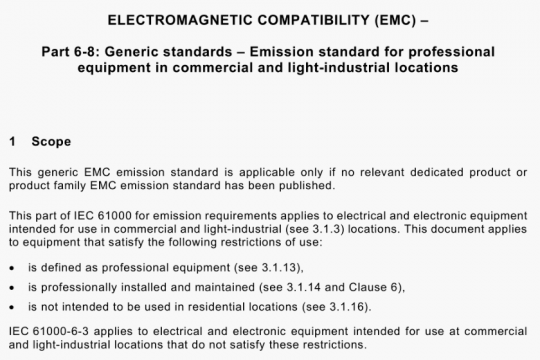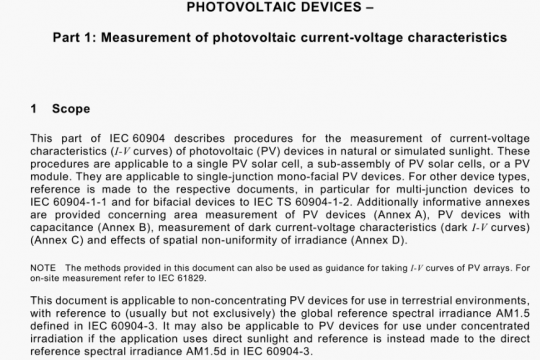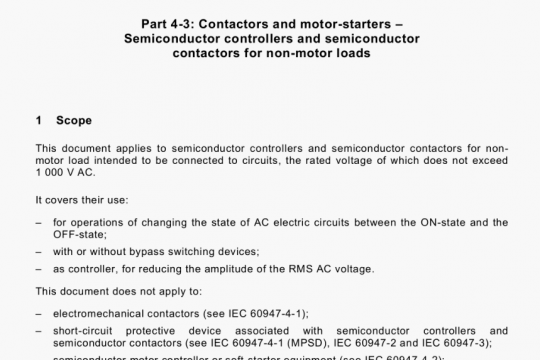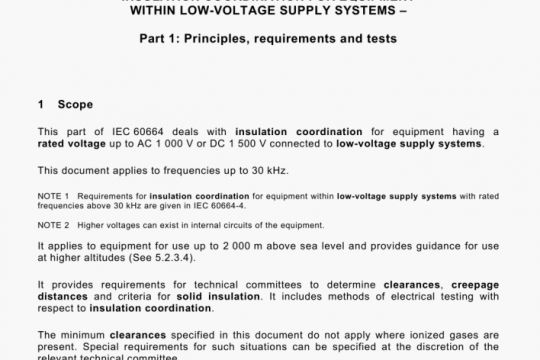IEC 61000-3-2-2018 pdf free
IEC 61000-3-2-2018 pdf free.Electromagnetic compatibility (EMC) – Part 3-2: Limits – Limits for harmonic current emissions (equipment input currents 16 A per phase).
The restrictions specified in 6.2 also apply to the categories of equipment listed in 7.1 for which no harmonic current limits apply.
The requirements and limits specified in this document are appIicabe to the power input terminals of equipment intended to be connected to 220/380 V, 230/400 V and 240/4 15 V systems operating at 50 Hz or 60 Hz. Requirements and limits for other cases are not yet specified.
A simplified test method is permitted for equipment that undergoes minor changes or updates, provided that, in previous full compliance tests, it has been shown to have current emissions below 60 % of the applicable limits and the TI-ID of the supply current is less than 15 %. The simplified test method consists of verifying that the updated equipment has an active input power within ±20 % of that of the originally tested product, and that the THD of the supply current is less than 15 %. Products that fulfill these requirements are deemed to comply with the applicable limits, but in case of doubt the result of a full compliance test according to Clauses 6 and 7 takes precedence over this simplified method.
6.2 Control methods
Asymmetrical controls according to IEC 60050-161:1990, 161-07-12, and half-wave rectification directly on the mains supply may only be used in the following circumstances:
a) where they are the only practical solution permitting the detection of unsafe conditions, or
b) where the controlled active input power is less than or equal to 100 W, or
c) where the controlled appliance is a portable equipment fitted with a two-core flexible cord and is intended for use for a short period of time, i.e. for a few minutes only.
If one of these three conditions is fulfilled, half-wave rectification may be used for any purpose, whereas asymmetrical controls may only be used for the control of motors.
Symmetrical control methods which can produce harmonics up to the 4O order in the input current may be used for the control of the power supplied to heating elements provided that the full sine-wave input power is less than or equal to 200 W, or that the limits of Table 3 are not exceeded.
Such symmetrical control methods are also allowed for professional equipment provided that
either
a) one of the above conditions is fulfilled, or
b) the relevant emission limits according to Clause 7 are not exceeded when tested at the supply input terminals and in addition both the following conditions are fulfilled:
1) it is necessary to control precisely the temperature of a heater whose thermal time constant is less than 2 s, and
2) there is no other technique economically available.
Professional equipment whose primary purpose, considered as a whole, is not for heating, shall be tested against the relevant emission limits according to Clause 7.
NOTE 2 An example of a product whose primary purpose is not heating is a photocopier, whereas a cooker Is considered to have heating as its primary purpose
Domestic equipment with symmetrical control used for a short time (for example hair dryers) shall be tested under Class A.
Even though asymmetrical controls and half-wave rectification are permitted under the conditions given above, the equipment shall still comply with the harmonic requirements of this document.
NOTE 3 When using asymmetrical controls or half-wave rectification under the above circumstances, the input current has a oc component that can disturb certain types of protection devices in case of an earth fault See
IEC TR 60755.
6.3 HarmonIc current measurement
6.3.1 Test configuration
Harmonic components shall be measured in accordance with the requirements given in Annex A for the test circuit and the supply source.
Specific test conditions for the measurement of harmonic currents associated with some types of equipment are given in Annex B.IEC 61000-3-2 pdf download.




